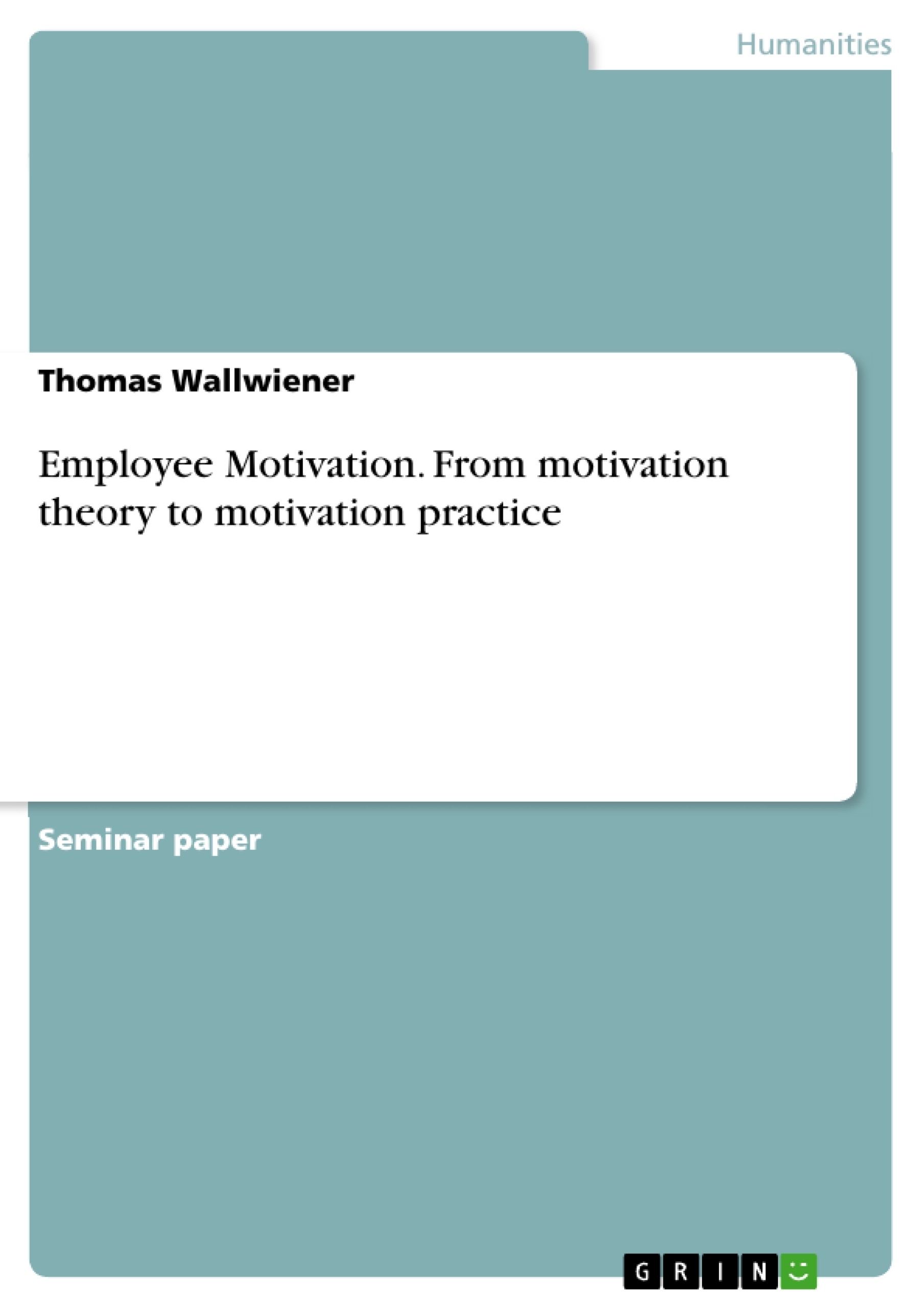In March 2010, the Gallup Institute published their annual study on employee motivation in German companies. The survey came to the conclusion that only 11% of employees in Germany are still committed to working for their company. Two-thirds of respondents said they only do "duty by the book" and avoid additional commitment. Almost a quarter (23%) are said to have already quit internally. These figures were obtained by Gallup from a survey conducted in September and October 2009. What is shocking about this study is that the previously mentioned data has been very constant for years. The economic damage caused by fluctuation, absenteeism and poor productivity is estimated by the Gallup Institute at between 92.3 and 121.5 billion euros per year. One of the main reasons for a lack of employee motivation is seen in the behavior of managers.
The present term paper deals with the topic of motivation and thus also with possible results of the above-mentioned study. Related to the professional environment the theoretical and the practical side are more near regarded. After a short introduction of the most important terms selected motivation theories are examined more near. Emphasis is placed here on the content theories. In the following chapter possibilities of the motivation increase are outlined. The focus here is on the leadership concepts of "management by ..." and forms of work organization.
Following the theoretical explanations, the theories are applied to a practical example. After describing the situation, the scenario is analyzed and possible solutions are formulated. Finally, the core statements of this paper are summarized and a conclusion is drawn.
Inhaltsverzeichnis (Table of Contents)
- Introduction
- Essential conceptual clarifications
- Concept of motivation
- Intrinsic motivation
- Extrinsic motivation
- Motivation
- Motivation theories
- Need-Hierarchy Theory by Maslow
- E-R-G theory by Alderfer
- X-Y theory by McGregor
- Two-factor theory of Herzberg
- Possibilities of increasing motivation
- Management by Delegation
- Management by Motivation
- Management by Objectives
- Organisation of work
- Job Enrichment
- Job Enlargement
- Job Rotation
- Case study
- Initial situation
- Situation analysis and evaluation
- Solutions and recommendations for increasing motivation
Zielsetzung und Themenschwerpunkte (Objectives and Key Themes)
This term paper aims to explore the concept of motivation in the professional environment, examining both theoretical and practical aspects. The paper investigates various motivation theories and their implications for increasing employee engagement, drawing upon the context of the annual Gallup Institute study on employee motivation in German companies.
- Understanding the concept of motivation and its different forms (intrinsic and extrinsic motivation).
- Analyzing key motivation theories, including Maslow's Need-Hierarchy Theory, Alderfer's E-R-G theory, McGregor's X-Y theory, and Herzberg's Two-factor theory.
- Exploring strategies for boosting motivation, such as delegation, motivation-based management, objective-setting, and various work organization approaches like job enrichment, enlargement, and rotation.
- Applying theoretical frameworks to a practical case study, evaluating the situation and proposing solutions to enhance motivation.
Zusammenfassung der Kapitel (Chapter Summaries)
- The introduction presents a concise overview of the term paper's focus and its connection to the Gallup Institute's findings on employee motivation in Germany. It highlights the significant economic impact of unmotivated employees, particularly concerning fluctuation, absenteeism, and productivity.
- The second chapter provides essential conceptual clarifications, defining the term "motivation" and distinguishing between intrinsic and extrinsic motivation. It further explores the five steps involved in the motivation process.
- The third chapter delves into prominent motivation theories, presenting in detail the Need-Hierarchy Theory by Maslow, the E-R-G theory by Alderfer, the X-Y theory by McGregor, and the Two-factor theory of Herzberg.
- The fourth chapter focuses on practical strategies for increasing motivation. It examines various management approaches like Management by Delegation, Management by Motivation, and Management by Objectives, as well as different forms of work organization, including job enrichment, enlargement, and rotation.
- The fifth chapter presents a case study where the previously discussed theoretical frameworks are applied to a practical scenario. This chapter includes an initial situation description, a situation analysis, and recommendations for boosting motivation.
Schlüsselwörter (Keywords)
This term paper focuses on key concepts related to employee motivation, including intrinsic motivation, extrinsic motivation, motivation theories, management by delegation, management by objectives, job enrichment, job enlargement, job rotation, and practical applications of these concepts in a case study setting. It also emphasizes the significance of the Gallup Institute study on employee engagement and its implications for German companies.
- Quote paper
- Thomas Wallwiener (Author), 2011, Employee Motivation. From motivation theory to motivation practice, Munich, GRIN Verlag, https://www.grin.com/document/1193918



